Ukraine |
|
|
|
| Übersicht – Contents: | |
Ukraine |
|
|
|
| Übersicht – Contents: | |
Flaggen – Flags: |
|
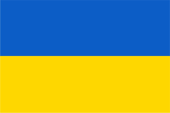 |
seit/since 2006, National-, Staats-, Handels- und Kriegsflagge – national, state, merchant and war flag, Seitenverhältnis – ratio 2:3, Quelle/Source, nach/by: Flags of the World   |
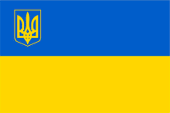 |
inoffizielle Flagge mit Wappen – unofficial flag with coat of arms, Seitenverhältnis – ratio 2:3, Quelle/Source, nach/by: Flags of the World |
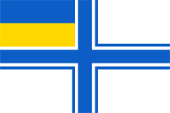 |
seit/since 2006, Marineflagge – naval flag, Seitenverhältnis – ratio 2:3, Quelle/Source, nach/by: Flags of the World |
 |
Gösch – naval jack, Seitenverhältnis – ratio 2:3, Quelle/Source, nach/by: Flags of the World, Foto |
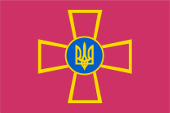 |
Flagge der Streitkräfte – flag of the armed forces, Seitenverhältnis – ratio 2:3, Quelle/Source, nach/by: Flags of the World |
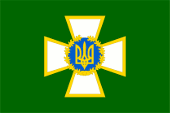 |
Flagge des Grenzschutzes – flag of the Border Patrol, Seitenverhältnis – ratio 2:3, Quelle/Source, nach/by: Flags of the World |
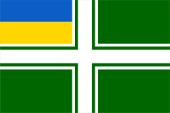 |
Flagge der Küstenwache – flag of the Coast Guard, Seitenverhältnis – ratio 2:3, Quelle/Source, nach/by: Flags of the World |
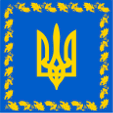 |
Flagge des Präsidenten – flag of the President, Seitenverhältnis – ratio 1:1, Quelle/Source, nach/by: Flags of the World |
historische Flaggen – historical Flags: |
|
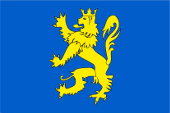 |
1848, inoffizielle Flagge – unofficial flag, Quelle/Source, nach/by: Flags of the World |
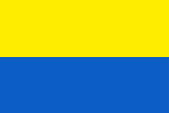 |
1917–1918, Flagge der Ukrainischen Volksrepublik – flag of the Ukrainian People's Republic, Quelle/Source, nach/by: Flags of the World   |
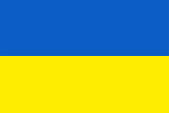 |
1918, Flagge des Ukrainischen Staates – flag of the Ukrainian State, Seitenverhältnis – ratio 2:3, Quelle/Source, nach/by: Wikipedia (EN)   |
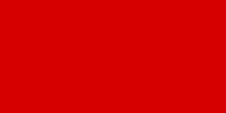 |
1917–1919, Flagge der Ukrainischen Sozialistischen Sowjetrepublik – flag of the Ukrainian Soviet Socialist Republic, Seitenverhältnis – ratio 1:2, Quelle/Source, nach/by: World Statesmen |
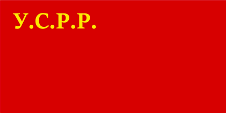 |
1919–1937, Flagge der Ukrainischen Sozialistischen Sowjetrepublik – flag of the Ukrainian Soviet Socialist Republic, Seitenverhältnis – ratio 1:2, Quelle/Source, nach/by: World Statesmen |
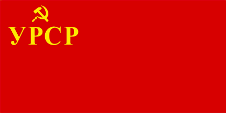 |
1937–1949, Flagge der Ukrainischen Sozialistischen Sowjetrepublik – flag of the Ukrainian Soviet Socialist Republic, Seitenverhältnis – ratio 1:2, Quelle/Source, nach/by: World Statesmen |
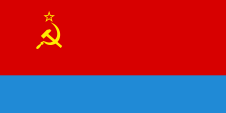 |
1949–1992, Flagge der Ukrainischen Sozialistischen Sowjetrepublik – flag of the Ukrainian Soviet Socialist Republic, Seitenverhältnis – ratio 1:2, Quelle/Source, nach/by: World Statesmen |
|
siehe auch – look also: Flaggengeschichte der Sowjetrepubliken der UdSSR – flag history of the soviet republics of the USSR |
|
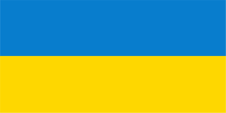 |
1991–1992, inoffizielle Flagge – unofficial flag, Seitenverhältnis – ratio 1:2, Quelle/Source, nach/by: Wikipedia (EN) |
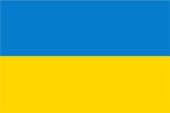 |
1992–2006, National-, Staats-, Handels- und Kriegsflagge – national, state, merchant and war flag, Seitenverhältnis – ratio 2:3, Quelle/Source, nach/by: Wikipedia (EN) |
 |
1992–1997, Marineflagge – naval flag, Seitenverhältnis – ratio = 1:2, Quelle/Source, nach/by: Flags of all Nations, Ministry of Defence, UK, 1999 |
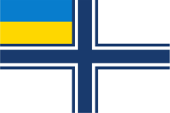 |
1997–2006, Marineflagge – naval flag, Seitenverhältnis – ratio = 1:2, Quelle/Source, nach/by: Wikipedia (EN) |
regionale Flagge – regional Flag: |
|
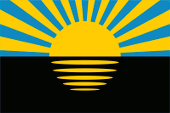 |
Flagge Bezirk/Oblast Donezk – flag of the District of Donetsk, Quelle/Source, nach/by: Flags of the World |
| Die heutige Flagge der Ukraine wurde erstmals am 29.04.1918 eingeführt, und am 28.01.1992 erneut angenommen. Sie zeigt zwei waagerechte Streifen in Blau und Gelb. Das helle Blau steht für den Himmel und das Goldgelb für die Weizenfelder des Landes. Gelb und Blau sind die Nationalfarben der Ukraine. Sie haben ihre Wurzeln in einem sehr alten Wappen von Galizien, das einen goldenen Löwen auf blauem Grund zeigte. Eine Flagge mit dieser Symbolik wurde im Jahr 1848 angenommen und auf dem Slawenkongress in Prag gezeigt. Kurz danach wurde jedoch vom Obersten Rat die Streifenflagge in Gold und Blau als Symbol angenommen. Nach der Russischen Revolution von 1905 tauchten in der Ukraine blau-gelbe und gelb-blaue Streifenflaggen auf. Nach der Bauernrevolte von 1917 wurde offiziell eine gelb-blaue Streifenflagge angenommen. Sie zeigte sie Streifen in der heraldisch korrekten Reihenfolge, Gelb über Blau. Nach einem Putsch im Jahre 1918 wurden die Farben umgedreht, und damit die heutige Flagge angenommen. Nachdem die russischen Bolschewisten die Ukraine bis zum Jahre 1919 erobert hatten, wurde umgehend eine Ukrainische Sowjetrepublik gegründet, die 1922 Gründungsmitglied der Sowjetunion wurde. Sie verwendete die typischen roten Flaggen mit den Initialen der Sowjetrepublik in der Oberecke, ab 1937 ergänzt um Hammer und Sichel. Im Jahre 1949 wurde eine neue Flagge für die Ukrainische Sowjetrepublik angenommen. Sie zeigte zwei waagrechte Streifen in Rot und Blau im Verhältnis 2:1 und in der Oberecke des großen roten Feldes Hammer, Sichel und Stern. Nach dem Ende der Sowjetunion im Jahr 1991 tauchte die blau-gelbe Fahne wieder auf und sie wurde am 28.01.1992 offiziell wieder eingefürt. Die Farben sind zuletzt 2006 per Gesetz festgelegt worden. Die Vorgabe ist: Blau = 2935 c, Gelb = Pantone Yellow 012 c. In den Jahre zuvor waren Flaggen mit einem hellern Blau, Himmelblau, in Verwendung. |
The today’s flag of
Ukraine was introduced for the first time on 29th of April in 1918, and
re-introduced on 28st of January in 1992. It shows two horizontal stripes in
blue and yellow. The pale blue stands for the heaven and the golden yellow
for the wheat fields of the country. Yellow and blue are the national
colours of Ukraine. They have their roots in a very old coat of arms of
Galicia, which showed a golden lion on blue ground. A flag with this
symbolism was adoped in the year 1848 and became showed on the Slavic
congress in Prague. Shortly afterwards, however, the Supreme Council adopted
the gold and blue striped flag as its symbol. After the Russian revolution of 1905 arised in the Ukraine blue-yellow and yellow-blue striped flags. After the farmer's revolt of 1917 was officially adoped a yellow-blue striped flag. It showed the stripes in the heraldic correct sequence, yellow over blue. After a coup d’état in the year 1918 the colours became inverted and in this way was adoped the today’s flag. After the Russian bolschevists conquered the Ukraine to the year 1919, was immediately established an Ukrainian soviet republic, which became founding component of the Soviet Union in 1922. It used the typical red flags with the initials of the soviet republic in the upper staff quadrant, since 1937 completed by hammer and sickle. In the year 1949 was adoped a new flag for the Ukrainian Soviet Republic. It showed two horizontal stripes in red and blue in ratio 2:1 and in the upper staff quadrant of the big red field hammer, sickle and star. After the end of the Soviet Union in 1991 arised the blue-yellow flag again and it became officially re-introduced on 28st of January in 1992. The colours were last defined by law in 2006. The specification is: Blue = 2935 c, yellow = Pantone Yellow 012 c. In previous years, flags with a lighter blue, sky blue, were in use. |
| Quelle/Source: Flaggen-Atlas Erde, Flaggen und Wappen der Welt, Flaggen Enzyklopädie, Volker Preuß | |
Wappen – Coat of Arms: |
|
 |
seit/since 1992, Wappen der Ukraine – coat of arms of Ukraine, Quelle/Source, nach/by: Alex Khristov, Public domain, via Wikimedia Commons |
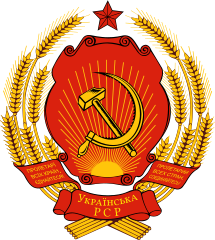 |
1949–1992, Wappen der Ukrainischen Sozialistischen Sowjetrepublik – coat of arms of the Ukrainian Soviet Socialist Republic, Quelle/Source, nach/by: Unknown, Public domain, via Wikimedia Commons |
| Das kleine Staatswappen der Ukraine zeigt einen blauen goldumrandeten Schild mit einem gelben Dreizack (ukrain.: Trizub). Dieses Symbol wurde schon um das Jahr 1000 auf Münzen der Kiewer Rus verwendet. Der Dreizack gilt als umstritten, daher wurde er auf Erlass des Präsidenten im Jahre 1992 nur für das kleine Wappen angenommen. Ein großes Wappen wurde bisher jedoch nicht eingeführt. | The small
coat of arms of Ukraine shows a blue golden bordered shield with a yellow
trident (ukrain.: Trizub). This symbol was already in use on coins of the
Rus of Kiev about the year 1000. The trident is disputed, from there was it adoped only for the small coat of arms by decree of the president in the year 1992. A big coat of arms hitherto was not introduced. |
| Quelle/Source: Flaggen und Wappen der Welt | |
Flugzeugkokarde – aircraft roundel: |
|
 |
Flugzeugkokarde – aircraft roundel Quelle/Source, nach/by: Wikipedia (EN) |
| Landkarte – Map: |
|
|
| Zahlen und Fakten – Numbers and Facts: | |
|
|
|
|
|
|
|
|
|
|
|
|
|
|
|
|
|
Antike
· Stämme der Ostslawen siedeln aus dem nördlichen Karpatenraum kommend im
Raum nördlich des Schwarzen Meeres an ab 800 · Schwedische Normannen, sogenanne Waräger, dringen über die Flüsse Memel (Neman), Westliche Dwina, Newa und Wolchow in Siedlungsraum der Ostslawen vor 862 · der Waräger Rjurik erobert die Stadt Nowgorod, der hiesige slawische Stamm der Slowenen erhebt Rjurik zum "Fürsten von Nowgorod", dieser begründet so die Nowgoroder Rus, einen normannischen Feudalstaat, und die bis 1598 herrschende Rjurik-Dynastie 862–880 · die Waräger erreichen den Dnjepr und dringen nach Süden vor ca. 882 · die Waräger Askold und Dir erobern Kiew und gründen die Kiewer Rus, einen weiteren normannischen Feudalstaat, der Waräger Oleg, Nachfolger von Rjurik, strebt die Vereinigung von Nowgorod und Kiew an 882 · Vereinigung von Kiew und Nowgorod, Gründung des Kiewer Reichs 911 · Oleg dringt entlang des Dnjepr bis zum Schwarzen Meer vor und belagert erfolgreich Konstantinopel, die Hauptstadt des Byzantinischen Reiches, Abschluss eines Handelsvertrages mit Byzanz 962–973 · Herrschaft des Swjatoslaw im Kiewer Reich, Feldzüge gegen die slawischen Stämme der Wjatitschen, Wolynier und Drewljanen, sowie gegen Chasaren und Wolgabulgaren 988 · Wladimir der Heilige führt das Christentum ein 1019–1054 · Herrschaft von Jaroslaw dem Weisen, das Kiewer Reich entfaltet seine größte Macht und Ausdehnung, im Norden bis an das Weiße Meer, im Osten bis zur Nördlichen Dwina, Suchona, Wolga, Oka, Don, im Süden bis an das Schwarze Meer, im Westen bis zu den Karpaten und fast bis zur Weichsel, sowie bis zur heutigen Ostgrenze der Baltischen Staaten ca. 1050–1150 · die Kumanen Erobern den Süden des Kiewer Reiches, Verlust des Zugangs zum Schwarzen Meer, Niedergang des Handels, beginnender Zerfall des Reiches ca. 1150 · das Kiewer Reich zerfällt in mehrere Staaten, die wichtigsten: Fürstentum Wladimir-Wolynien im Westen, Rus von Nowgorod im Nordwesten, und Fürstentum Wladimir-Susdal im Nordosten, Galitsch und Kiew im Süden, Murom-Rjasan im Osten 1237 · Ankunft der Mongolen, Fall von Rjasan 1237–1238 · Eroberung von Wladimir-Susdal durch die Mongolen 1240 · Eroberung von Kiew, Wladimir-Wolynien und Galitsch durch die Mongolen 1350–1365 · Eroberung von Wolhynien, Polodlien, Galitsch (Galizien) und Kiew (Ukraine) durch Polen 1648 · Aufstände gegen die polnische Herrschaft, Gründung eines ukrainischen Kosakenstaates 1654 · die Ost-Ukraine wird von Polen an Russland abgetreten und wird eine russische Provinz 1772 · Erste Polnische Teilung, um dem wachsenden russischen Einfluss im Polnischen Staat entgegenzuwirken, sichern Österreich und Preußen weite polnische Gebiete vor dem russischen Zugriff durch deren Annexion, Preußen annektiert Westpreußen, Ermland, Pommerellen (ohne Danzig), das Kulmer Land, das nördliche Kujawien und das Netzegebiet, Österreich annektiert Galizien, die südlichen Teile der Wojewodschaften Krakau und Sandomir, die Wojewodschaft Reussen mit Lemberg, Rußland annektiert alles polnische Territorium östlich der Düna und des Dnjepr, in der Folgezeit erreichen die Zustände im Land eine deutliche Besserung, jedoch ruft die Magnatenkonföderation (Adelsversammlung) von Targowitza im Jahre 1792 russische Hilfe ins Land 1793 · Zweite Polnische Teilung, um erneut dem wachsenden russischen Einfluss im Polnischen Staat entgegenzuwirken, sichert Preußen weitere polnische Gebiete vor dem russichen Zugriff durch deren Annexion, Preußen annektiert Großpolen (Südpreußen) und Danzig), Rußland annektiert die Ukraine, Ost-Polesien und Ost-Wolynien, daraufhin kommt es 1794 zum nationalen Volksaufstand unter Tadeusz Kosciuszko, der sich vor allem gegen die Russen und den pro-russischen Adel richtete, erneuter politischer, wirtschaftlicher und kultureller Verfall 1795 · Dritte Polnische Teilung, um dem weiter wachsenden russischen Einfluss in Polen entgegenzuwirken, sichern Österreich und Preußen wiederum weite polnische Gebiete vor dem russichen Zugriff durch deren Annexion, Preußen annektiert Neuostpreußen (Masowien und Teile Litauens), Österreich annektiert Kleinpolen (West-Galizien), Rußland annektiert alles verliebene polnische Territorium (West-Polesien und West-Wolynien, Litauen und Kurland), die Existenz des polnischen Staats war damit beenedet 12.03.1917 · bürgerliche "Februarrevolution" in Russland 15.03.1917 · Abdankung des Zaren Nikolaus II., Ende der Monarchie, Bildung einer provisorischen Regierung der Republik Russland unter Fürst Georgij Jewgenjewitsch Lwow, später unter Alexander Fjodorowitsch Kerenskij März 1917 · anarchistischer Bauern-Putsch in der Ukraine, sie löst sich von Russland und erklärt ihre Unabhängigkeit 07.11.1917 · bolschewistischer Putsch in Russland ("Oktoberrevolution"), Kommunisten unter W.I.Lenin ergreifen die Macht Februar bis Mai 1918 · Erster Weltrieg (1914–1918), da die Bolschewisten die Unterzeichnung des Friedens von Brest-Litowsk verzögerten, besetzten deutsche und österreichische Truppen große Teile Weißrusslands, der Ukraine und Russlands, in etwa bis zu den Flüssen Don, Donez, Sejm, Dnjepr und Welikaja 29.04.1918 · Militärputsch in der Ukraine 11.11.1918 · Ende des Ersten Weltkriegs, die deutschen und österreichischen Truppen ziehen sich aus der Ukraine zurück 1918–1919 · Krieg Sowjetrusslands gegen die Ukraine, Errichtung der Sowjetmacht, Deportationen nach Sibirien, die Ukraine wird zur Ukrainischen Sozialistischen Sowjetrepublik 30.12.1922 · Gründung der Sowjetunion (UdSSR), Zusammenschluss der Sowjetrepubliken von Russland (RSFSR), Weißrussland, der Ukraine und der Transkaukasischen Föderation 1932–1933 · Kollektivierung der Landwirtschaft, Hungersnot, Tod von ca. 3,5 Millionen Ukrainern (Holodomor) 1941–1944 · im Zweiten Weltkrieg von deutschen Truppen besetzt, Ukrainer kämpften in großer Zahl innerhalb der Sowjetischen Truppen gegen die Deutschen, jedoch erhofften sich einige Ukrainer (ca. 300.000) eine Befreiung von Russland und vom Bolschewismus und kämpften in den Reihen der Deutschen Wehrmacht, oder Spezialeinheiten auf der Seite des Deutschen Reiches 24.10.1945 · Gründungsmitglied den Vereinten Nationen (UNO) 1944–1947 · Vertreibung fast aller Polen aus der Ukraine (ca. 1 000 000), Ansiedlung von aus Polen vertriebenen Ukrainern (ca. 400 000) 1944–1947 · Anti-Sowjetischer Partisanenkrieg 1954 · die Halbinsel Krim wird der Ukraine angegliedert 16.07.1990 · die Ukraine erklärt ihre Souveränität 24.08.1991 · die Ukraine erklärt ihre Unabhängigkeit 08.12.1991 · Russland, die Ukraine und Weißrussland gründen die "Gemeinschaft Unabhängiger Staaten" (GUS) 21.12.1991 · Beitritt aller ehemaligen Sowjetrepubliken der UdSSR zur GUS (außer Georgien), endgültiges Ende der Sowjetunion 1994 · Wahlen, Sonderstatus für die Krim 1996 · Verfassung für die Krim, sie wird autonome Republik Januar 2014 · Putsch (nicht verfassungskonformer Machtwechsel), Unruhen 16.03.2014 · Volksabstimmung in der Republik Krim, eine überwältigende Mehrheit stimmt für einen Anschluss an Russland, am 18.03. beschließt das Parlament der Krim den Anschluss an Russland, am 20.03. beschließt das russische Parlament den Anschluss der Republik Krim an die Russische Föderation 07.04.2014 · Proklamation der (Russischen) Republik Donezk im Donbass-Gebiet, später auch der Republiken Lugansk, Charkow und Odessa 11.05.2014 · Volksabstimmungen in den Republiken Lugansk und Donezk bestätigen die Souveränität der Republiken mit großer Mehrheit Februar 2022 · Russland marschiert in der Ukraine ein und beginnt einen Krieg, quasi als Eskalation des seit 2014 schwelenden Russisch-Ukrainischen Konfliktes im Donbass-Gebiet 30.09.2022 · Anschluss der Republiken Lugansk und Donezk und der Gebiete Cherson und Saporischschja an die Russische Föderation |
|
antiquity
· tribes of the Eastern Slavs settle – coming from the Northern Carpathian
Area – in the region northern the Black Sea since 800 · Swedish Normans, so named Varegers, invade over the rivers Memel (Neman), Western Dvina, Neva and Volchov into the environment of the Eastern Slavs 862 · the Vareger Rjurik conquers the town of Nowgorod, the local Slavonic tribe of the Slovenes levies Rjurik to the "Prince of Novgorod", that establishes in this way the Rus of Novgorod, a Norman feudal state, and the until 1598 ruling Rjurik Dynasty 862–880 · the Varegers reach the Dnjepr River and advance to south ca. 882 · the Varegers Askold and Dir conquer Kiev and establish the Rus of Kiev, a further Norman feudal state, the Vareger Oleg, successor of Rjurik, aims for the unification of Novgorod and Kiev 882 · unification of Kiev and Novgorod, establishment of the Empire of Kiev 911 · Oleg advances along Dnjepr River to the Black Sea and beleaguered successfully Constantinople – the capital of the Byzantian Empire, making of a trade treaty with Byzantium 962–973 · reign of Svjatoslav in the Empire of Kiev, campaigns against the Slavonic tribes of the Vjatitshes, Wolynians and Drevljans, as well as against Chasars and Volga Bulgarians 988 · Vladimir the Saint introduces the Christianity 1019–1054 · reign of Yaroslav the Wise, the Empire of Kiev evolves its greatest power and dilation, in the north to the White Sea, in the East to the rivers Northern Dvina, Sukhona, Volga, Oka, Don, in the south to the Black Sea, in the west to the Carpathia Mountains and nearly to the Weichsel River, as well as to the today’s eastern border of the Baltic states ca. 1050–1150 · the people of Kumans conquers the south of the Empire of Kiev, loss of accession to the Black Sea, decay of trading, beginning disintegration of the empire ca. 1150 · the Empire of Kiev disintegrates in several states, the most important: Principality of Vladimir-Wolynia in the west, Rus of Novgorod in the northwest, and Principality of Vladimir-Susdal in the northeast, Galitsh and Kiev in the south, Murom-Rjasan in the east 1237 · arrival of the Mongols, fall of Rjasan 1237–1238 · conquest of Vladimir-Susdal by the Mongols 1240 · conquest of Kiew, Wladimir-Wolynia and Galitsh by the Mongols 1350–1365 · conquest of Wolynia, Polodlia, Galitsh (Galicia) and Kiev (Ukraine) by Poland 1648 · riotings against the Polish rule, establishment of an Ukrainian Cossack state 1654 · the Eastern Ukraine becomes ceded from Poland to Russia and becomes a Russian province 1772 · First Polish Division, to counteract the growing Russian influence in the Polish state protect Austria and Prussia broad Polish territories against the Russian pounce by its annexation, Prussia annexes West Prussia, Ermland, Pommerellen (without Danzig), the Kulm Country, the northern Kuyavia and the Netze Area, Austria annexes Galicia, the southern parts of the Districts of Krakau and Sandomir, the District of Reussen with Lemberg, Russia annexes all Polish territory eastern the Duena River and the Dnjepr River, in the afteryears the conditions in the country become conspicuously better, but the Confederation of Magnats (nobilitie's assembly) of Targowica in the year 1792 calls for Russian support 1793 · Second Polish Division, to counteract the growing Russian influence in the Polish state again protects Prussia once more broad Polish territories against the Russian pounce by its annexation, Prussia annexes Great Poland (South Prussia) and Danzig, Russia annexes the Ukraine, Eastern Polesia and Eastern Wolynia, as a result of that in 1794 occurs the national people's revolt under Tadeusz Kosciuszko which was especially orientated against the Russians and the pro-Russian aristocracy, once more political, economical and cultural decline 1795 · Third Polish Division, to counteract the more growing Russian influence in the Polish state again protect Prussia ans Austria once more broad Polish territories against the Russian pounce by its annexation, Prussia annexes New East Prussia (Masovia and parts of Lithuania), Austria annexes Little Poland (Western Galicia), Russia annexes all the remained Polish territory (Western Polesia and Western Wolynia, Lithuania and Kurland), the existence of the Polish state finished 12th of March 1917 · civil "Februar Revolution" in Russia 15th of March 1917 · resignation of Tsar Nikolaus II., end of monarchy, formation of a provisional government of the Republic of Russia under Prince Georgij Jevgenyewitsh Lvov, later under Alexander Fyodorowitsh Kerenskij March 1917 · anarchistic farmer's revolt in Ukraine, it separates from Russia and declares its independence 7th of November 1917 · bolshevist coup d’état ("October Revolution"), communists under W.I.Lenin seize the Power February to May 1918 · First World War (1914–1918), because the Bolshevists retarded the signing of the Peace of Brest-Litovsk, German and Austria-Hungaryn troops occupied large parts of Belarus, Ukraine and Russia, ca. to the rivers Don, Donez, Sejm, Dnjepr and Velikaya 29th of May 1918 · military coup d’état in the Ukraine 11th of November 1918 · end of the First World War, the German and Austrian troops withdraw from Ukraine 1921 · war of Soviet Russia against Ukraine, estblishment of the Soviet power, deportations to Sibiria, the Ukraine becomes the Ukrainian Socialistic Soviet Republic 30th of December 1922 · founding of the Soviet Union (USSR), combination of the Soviet Republics of Russia (RSFSR), Belarus (White Russia), Ukraine and of the Transcaucasian Federation 1932–1933 · collectivization of farming, famine, death of ca. 3,5 millions of Ukrainians (Holodomor) 1941–1944 · occupied by German troops in the Second World War, Ukrainian fight in large numbers within the Soviet troops against the Germans, but some Ukrainians (ca. 300.000) hoped for a liberation from Russia and from the bolshevism and fought within the lines of the German War Might, or within special units by the hands of the German Empire 24th of October 1945 · Founding member of the United Nations (UNO) 1944–1947 · expulsion of nearly all Polish out of the Ukraine (ca. 1 000 000), settlement of from Poland expulsed Ukrainians (ca. 400 000) 1944–1947 · anti-soviet partisan war 1954 · Crimea peninsula becomes annexed to Ukraine 16th of July 1990 · the Ukraine declares its sovereignty 24th of August 1991 · the Ukraine declares its independence 8th of December 1991 · Russia, Ukraine and Belarus (White Russia) establish the "Commonwealth of Independent States" (CIS) 21st of December 1991 · joining of all former Soviet Republics of the USSR to the CIS (except Georgia), irrevocable end of the Soviet Union 1994 · elections, special status for Crimea 1996 · constitution for Crimea, it becomes an autonomous republic January 2014 · coup (not constitutionally compliant change of power), riots 16th of March in 2014 · referendum in the Republic of Crimea, an overwhelming majority votes in favor of a connection to Russia, on 18th of March the parliament of Crimea decides the affiliation to Russia, on 20th of March the parliament of Russia decides the affiliation of the Republic of Crimea to the Russian Federation 7th of April in 2014 · proclamation of the (Russian) Republic of Donetsk in Donbass Area, later also of the Republics of Luhansk, Kharkiv and Odessa 11th of May in 2014 · referendums in the Republics of Luhansk and Donetsk confirm the sovereignty of the republics by a large majority February 2022 · Russia invades Ukraine and starts a war, virtually as an escalation of the Russian-Ukrainian conflict in the Donbass region that has been simmering since 2014 30th of September in 2022 · annexation of the Republics of Luhansk and Donetsk and the Kherson and Zaporizhzhya Oblasts to the Russian Federation |
| Quelle/Source: Atlas zur Geschichte, World Statesmen, Die Völker der Erde, Avantgarde für Europa, Weltgeschichte, Wikipedia (D) |
| Der Name der Ukraine leitet sich ab von der russischen Redewendung "u kraijna", was "an der Grenze" heißt. Die Ukraine ist das "Grenzland". | The name
Ukraine is derived from the Russian expression "u kraijna", what means "at
the border". The Ukraine is the "border land". |
| Quelle/Source: Handbuch der geographischen Namen | |